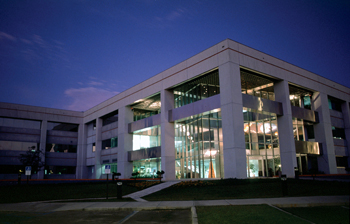
The National High Magnetic Field Laboratory at Florida State University is planning to build a state-of-the-art magnet system that will transform the study of complex environmental and biological samples. A better understanding of fossil and biological fuels, for example, could lead to applications for reducing carbon emissions and the development of new, sustainable fuels.
The 21-tesla superconducting magnet, combined with a small cyclotron spectrometer (a machine that measures the mass of molecules), is made possible by a $17.5 million grant from the National Science Foundation’s Division of Chemistry, $15 million of which comes from funds made available through the American Recovery and Reinvestment Act of 2009.
“This award pushes the frontier of large molecule analyses and further strengthens our world leadership in ion-cyclotron resonance capabilities,” said Kirby Kemper, vice president for Research at Florida State.
The magnet system will be housed in the National High Magnetic Field Laboratory’s Ion Cyclotron Resonance (ICR) facility and will be used for Fourier transform ICR mass spectrometry — a powerful analytical technique capable of resolving and identifying thousands of different chemical components simultaneously in complex mixtures.
The addition of a 21-tesla magnet is expected to yield major innovations in the field of chemical analysis. Going from 14.5 to 21 tesla — a 45-percent increase in field — will increase the accuracy of mass measurements by a factor of at least 2, raising it to an astonishing 50 parts per billion.
“This grant will give us the opportunity to see the chemical and molecular world in unprecedented detail — sort of like HDTV compared to ordinary TV,” said Alan Marshall, director of the magnet lab’s ICR User Program and the Robert O. Lawton Professor of Chemistry and Biochemistry at Florida State. Marshall, who co-invented the FT-ICR technique and continues to develop it, is the principal investigator on the grant.

The ICR User Program facility serves more than 100 external researchers per year and leads the world in instrument and applications development for the technique. Since the technique’s inception, more than 775 FT-ICR instruments have been installed in laboratories worldwide. In addition, the ICR program at Florida State has trained 32 undergraduates and 42 postdoctoral fellows, and generated five M.S. and 21 Ph.D. graduates, for careers in industry, government and academia.
The 21-tesla magnet system will raise research already under way at the magnet lab to new heights. Areas of research include:
- Petroleomics — Analysis of the world’s most complex mixture, petroleum. More precise analysis of crude oil samples can lead to better, faster and more efficient drilling, refining and delivery.
- Proteomics — The analysis and cataloging of proteins. To understand biological processes, scientists need to learn how proteins function in cells. Proteins, which compose much of the machinery of living cells, will be analyzed intact (top-down) rather than in pieces (bottom-up) as at present, a particularly promising direction for discovery of new drugs and their mechanism of action.
- Biofuels — Analysis of the chemical composition of biofuels. Although ethanol is the first widely used biofuel, other sources, including algae and pine trees, offer potentially better performance and less environmental impact. The new instrument will provide detailed insight into biofuels at every stage of their production and use. “The Chemistry Division at the NSF is very excited about this unique and potentially transformative project, which would not have been possible to fund without the availability of Recovery Act funds,” said Luis Echegoyen, director of the division.
Florida State has received its first year of funding for the project. The system’s design and construction is proceeding by competitive bids from the world’s leading magnet manufacturers; the complete spectrometer should be ready in four years.
The National High Magnetic Field Laboratory develops and operates state-of-the-art, high-magnetic-field facilities that faculty and visiting scientists and engineers use for research. The laboratory is sponsored by the National Science Foundation and the state of Florida. To learn more, visit www.magnet.fsu.edu.




